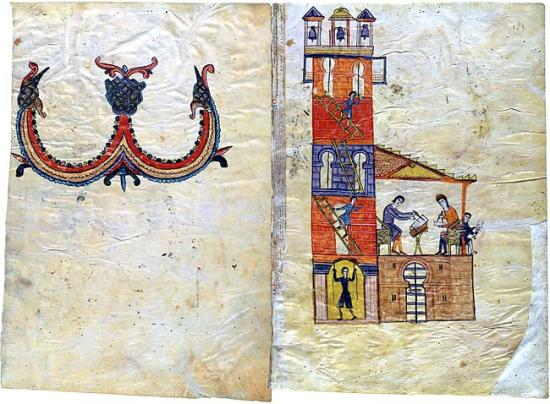
Omega And The Tower Scriptorium Of Tábara
Beatus of Liébana
Las Huelgas Apocalypse
Purchased by Pierpont Morgan, 1910
In the Apocalypse Christ refers to himself several times as the Alpha and Omega. Thus some Beatus manuscripts begin and end with monumental images of those two Greek letters. When the Morgan manuscript was rebound during the seventeenth century, the final bifolio containing the omega and the tower was turned inside out by the binder, who thought he was correcting a previous mistake. Thus the omega incorrectly ended up as the last illustration. Now, for the first time since then, the original order of these last two images has been restored. The representation of the celebrated scriptorium of San Salvador de Tábara was copied from a Beatus manuscript completed in Tábara in 970. The two images are the earliest "portraits" of a medieval scriptorium in a manuscript. It shows the scribe and illuminator laying out their folios, while a novice trims parchment. In the tower, three men ring the bells, which functioned as the community's clock.
The Apocalypse, or Book of Revelation, is not only the last Book of the New Testament, but its most difficult, puzzling, and terrifying. It provided challenges to medieval illustrators and was the source for a number of popular images, such as Christ in Majesty, the Adoration of the Lamb, and the Madonna of the Apocalypse and contributed to the widespread use of the Evangelists' symbols.
Selected images from Apocalypse Then: Medieval Illuminations from the Morgan, an exhibition held at the Morgan are presented here. The exhibition celebrates the completion of a facsimile of the Morgan's Las Huelgas Apocalypse—the latest dated (1220) and largest surviving manuscript of a Spanish tradition of illuminated commentaries on the Apocalypse by the monk Beatus of Liébana. The series of manuscripts constitutes Spain's most important contribution to medieval manuscript illumination.
The Las Huelgas Apocalypse contains three sections: the prefatory cycle, the Apocalypse, and the Book of Daniel.
In addition to forty-nine images from the Las Huelgas Apocalypse, six images from other manuscripts in the Morgan's collections, including the earliest Beatus painted by Maius and one by the Master of the Berry Apocalypse, are in this presentation.
